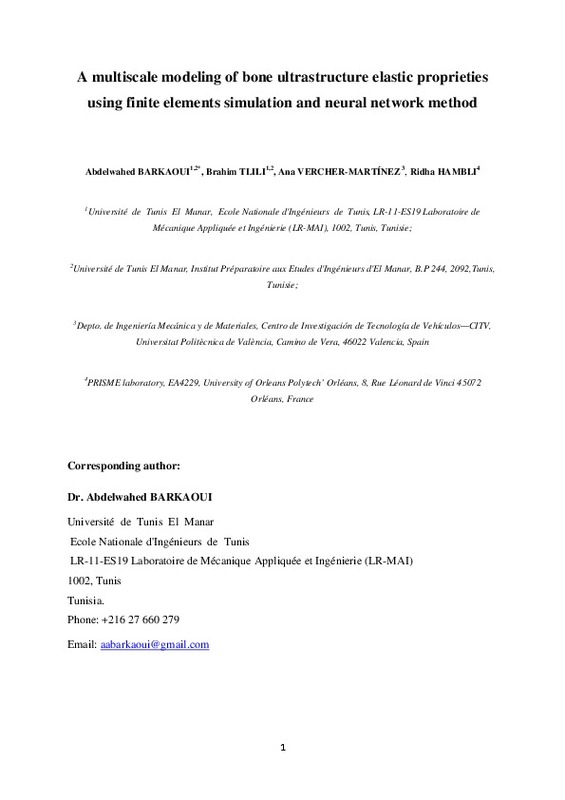JavaScript is disabled for your browser. Some features of this site may not work without it.
Buscar en RiuNet
Listar
Mi cuenta
Estadísticas
Ayuda RiuNet
Admin. UPV
A multiscale modelling of bone ultrastructure elastic properties using finite elements simulation and neural network method
Mostrar el registro sencillo del ítem
Ficheros en el ítem
| dc.contributor.author | Barkaoui, Abdelwahed
|
es_ES |
| dc.contributor.author | Tlili, Brahim
|
es_ES |
| dc.contributor.author | Vercher Martínez, Ana
|
es_ES |
| dc.contributor.author | Hambli, Ridha
|
es_ES |
| dc.date.accessioned | 2017-06-05T08:53:20Z | |
| dc.date.available | 2017-06-05T08:53:20Z | |
| dc.date.issued | 2016-10 | |
| dc.identifier.issn | 0169-2607 | |
| dc.identifier.uri | http://hdl.handle.net/10251/82324 | |
| dc.description.abstract | Bone is a living material with a complex hierarchical structure which entails exceptional mechanical properties, including high fracture toughness, specific stiffness and strength. Bone tissue is essentially composed by two phases distributed in approximately 30 70%: an organic phase (mainly type I collagen and cells) and an inorganic phase (hydroxyapatite-HA-and water). The nanostructure of bone can be represented throughout three scale levels where different repetitive structural units or building blocks are found: at the first level, col-lagen molecules are arranged in a pentameric structure where mineral crystals grow in specific sites. This primary bone structure constitutes the mineralized collagen microfibril. A struc-tural organization of inter-digitating microfibrils forms the mineralized collagen fibril which represents the second scale level. The third scale level corresponds to the mineralized col-lagen fibre which is composed by the binding of fibrils. The hierarchical nature of the bone tissue is largely responsible of their significant mechanical properties; consequently, this is a current outstanding research topic. Scarce works in literature correlates the elastic prop-erties in the three scale levels at the bone nanoscale. The main goal of this work is to estimate the elastic properties of the bone tissue in a multiscale approach including a sensitivity analy-sis of the elastic behaviour at each length scale. This proposal is achieved by means of a novel hybrid multiscale modelling that involves neural network (NN) computations and finite elements method (FEM) analysis. The elastic properties are estimated using a neural network simulation that previously has been trained with the database results of the finite element models. In the results of this work, parametric analysis and averaged elastic constants for each length scale are provided. Likewise, the influence of the elastic constants of the tissue constituents is also depicted. Results highlight that intelligent numerical methods are pow-erful and accurate procedures to deal with the complex multiscale problem in the bone tissue with results in agreement with values found in literature for specific scale levels. | es_ES |
| dc.language | Inglés | es_ES |
| dc.publisher | Elsevier | es_ES |
| dc.relation.ispartof | Computer Methods and Programs in Biomedicine | es_ES |
| dc.rights | Reserva de todos los derechos | es_ES |
| dc.subject | Bone ultrastructure | es_ES |
| dc.subject | Multiscale modelling | es_ES |
| dc.subject | Finite element method | es_ES |
| dc.subject | Neural network computation | es_ES |
| dc.subject | Elastic properties | es_ES |
| dc.subject.classification | INGENIERIA MECANICA | es_ES |
| dc.title | A multiscale modelling of bone ultrastructure elastic properties using finite elements simulation and neural network method | es_ES |
| dc.type | Artículo | es_ES |
| dc.identifier.doi | 10.1016/j.cmpb.2016.07.005 | |
| dc.rights.accessRights | Abierto | es_ES |
| dc.contributor.affiliation | Universitat Politècnica de València. Escuela Técnica Superior de Ingenieros Industriales - Escola Tècnica Superior d'Enginyers Industrials | es_ES |
| dc.description.bibliographicCitation | Barkaoui, A.; Tlili, B.; Vercher Martínez, A.; Hambli, R. (2016). A multiscale modelling of bone ultrastructure elastic properties using finite elements simulation and neural network method. Computer Methods and Programs in Biomedicine. 134:69-78. doi:10.1016/j.cmpb.2016.07.005 | es_ES |
| dc.description.accrualMethod | S | es_ES |
| dc.relation.publisherversion | http://doi.org/10.1016/j.cmpb.2016.07.005 | es_ES |
| dc.description.upvformatpinicio | 69 | es_ES |
| dc.description.upvformatpfin | 78 | es_ES |
| dc.type.version | info:eu-repo/semantics/publishedVersion | es_ES |
| dc.description.volume | 134 | es_ES |
| dc.relation.senia | 317120 | es_ES |
| dc.identifier.eissn | 1872-7565 |






![[Cerrado]](/themes/UPV/images/candado.png)


